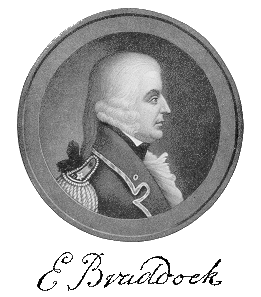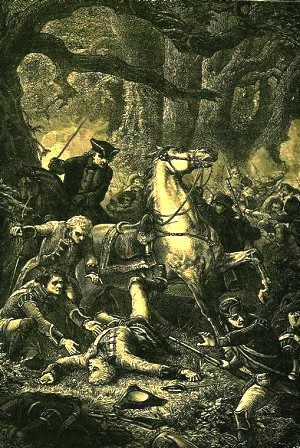“What! A provincial colonel teaches a British general how to fight!”

General Edward Braddock was receiving advice from a young George Washington. Washington was suggesting that he disperse his army and fight behind trees as the Indians did.
General Braddock was slow to do as the younger officer advised, and he would pay dearly.
This was no mere battle they had been lured into. It was an ambush waiting to spring. George Washington’s warning came in vain. Arrows and bullets killed many men in Braddock’s ranks because they were all confused from the war whoops and yells they heard from the other side of the field.
Everyone was scattering. Braddock tried to encourage his men by example and shouting for them to follow.
Two hours into the fight, Edward Braddock had lost many officers and men to the enemy’s weapons. At last, his only aide was young Washington, who carried Braddock back to camp after he had been mortally wounded in the chest.
General Braddock’s Overly Confident Attitude
Edward Braddock was most famous for his disastrous mistake made during the French Indian War (1754 – 1763).
He was a major general who fought with both British and American forces with General Washington as his assistant. It was July of 1755, early in the war, when he marched with British soldiers, far too confidently, to capture Fort Duquesne.
Benjamin Franklin Describes General Edward Braddock
“This general was, I think, a brave man, and might probably have made a figure as a good officer in some European war. But he had too much self-confidence, too high an opinion of the validity of regular troops, and too mean a one of both Americans and Indians. …
“I ventured only to say, ‘ … The only danger I apprehend of obstruction to your march is from ambuscades of Indians, who, by constant practice, are dexterous in laying and executing them. … ‘
“He smiled at my ignorance, and replied, ‘These savages may, indeed, be a formidable enemy to your raw American militia, but upon the King’s regular and disciplined troops, sir, it is impossible they should make any impression.” (Kennedy, Bailey, & Bailey, The American Spirit: United States History As Seen by Contemporaries, Vol. 1; [Boston: Wadsworth Cengage Learning, 2010] p. 110, emphasis ours)
Famous last words indeed!
His underestimation of French and Indian forces in Ohio Country cost him his life in the end.
Edward Braddock Biography

Edward Braddock was born in 1695 in Pertheshire, Scotland to General Edward Braddock and his wife, whose name is unknown.
When Edward was 15 years of age, he joined the Coldstream Guards of Britain. During the years he moved up through the ranks and eventually reached the rank of lieutenant colonel. In 1774, he served under the Prince of Orange in Holland. After seven years in faithful service and friendship to King George III, he became a major general.
In February of 1755, he arrived in Virginia to join forces with the generals there and take back Fort Duquesne for Britain and America. It was in Virginia that he met young George Washington and worked with him to fight against the French and Indian forces in Ohio.
At the end, General Braddock fought vigorously but was defeated. Four of Braddock’s horses that he rode into battle were killed until he, on his fifth steed, finally fell. The bullet had gone through his chest and hit one of his lungs. He died four days later, on July 13, 1755.
It is said that he gave his battle sash to George Washington, who later became the president of the United States of America, and Washington continued to wear the piece of clothing even after the American Revolutionary War had been fought.


